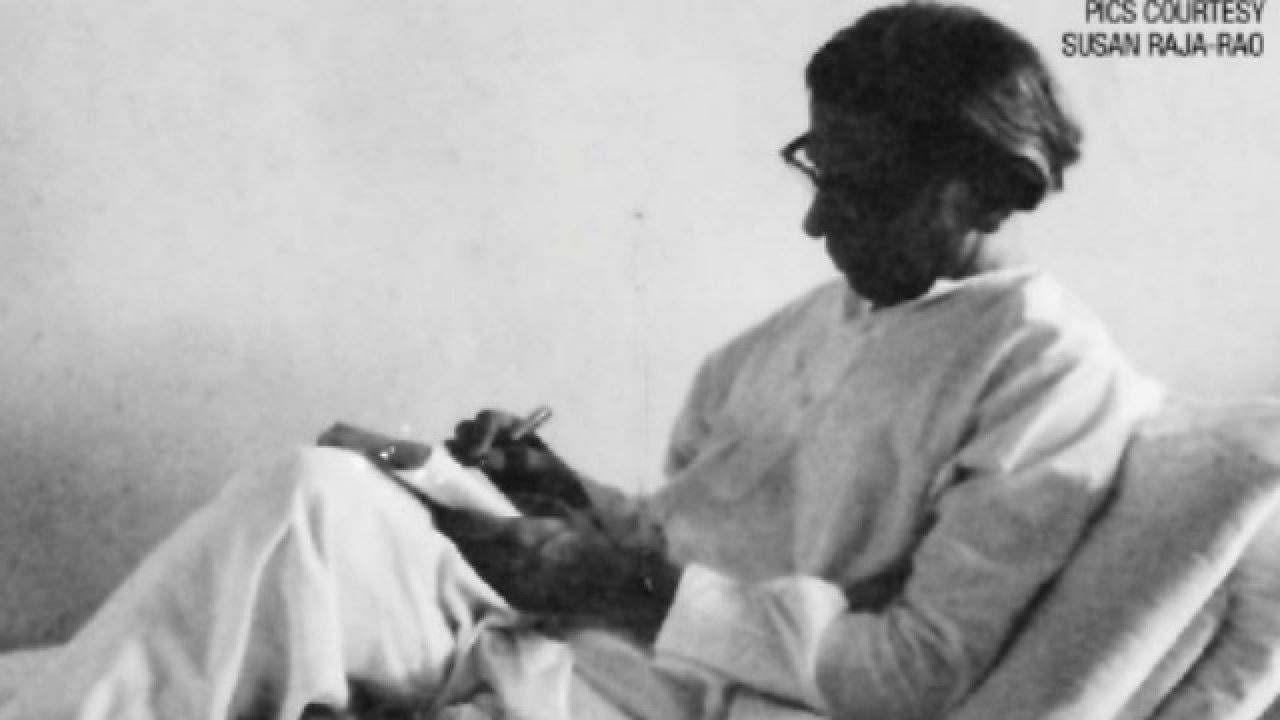
November 8, 2016 is Raja Rao’s 108th birthday. It is an occasion to remember one of the greatest literary geniuses of the 20th century, who passed away on 8 July 2006 at the age of 96.
108 is a number sacred to Hindus, Buddhists, Jains, and other wisdom traditions of the world. Our japa mala, rosary of repetition and remembrance, has 108 beads. The 109th bead, the “Guru” bead, is where the mala is turned back after the completion of one punahcharana or repetition to re-commence a new cycle. The mystery of 108 may have something to do with the distance between the earth and the sun, which is approximately 108 times the latter’s diameter. What is, perhaps, equally significant is that the distance between the earth and the moon is 108 times the latter’s diameter.
Many ancient peoples, starting with the Egyptians, knew of these amazing numerical and astronomical conjunctures. What they deduced was that there was an intended series of correspondences between the “lower,” earthly realms of existence and the “higher,” heavenly ones. This reciprocal symmetry between the microcosm and the macrocosm, they surmised, could not be accidental: it signified the seal and proof of own divine nature.
Each repetition of the japa mala, thus, was meant as a profoundly significant symbolic imitation or anukraman of the earth’s revolution around the sun, the source of all planetary life. The moon also went around the earth in a similar fashion. The rotation of a rosary, thus, was akin to a cosmic movement and of significance that was similar.
Raja Rao’s 108th birthday, thus, shouldn’t pass unmarked. But this only begs the question: why bother? What do we lose by not remembering Raja Rao? For the younger generation, the name Raja Rao draws a mental blank, meaning little. This is equally true of other “greats” from the past, all but forgotten today.
The truth is that Raja Rao was not only one of the grand trimurti or trinity of Indian English writers who burst into prominence in the 1930s, the other two being Mulk Raj Anand, RK Narayan. He also voiced the central problematic if not credo of all Indian English creativity: how to voice in a language not one’s own (English) reality that is so intimately ours (Indian)?
Raja Rao met this challenge by inventing new ways of writing in English, sometimes bringing to it the cadences and flavours of his native Kannada as in Kanthapura (1938), at other times aspiring to the lofty rhythms and philosophical heights of India’s Deva Bhasha, Sanskrit, as in The Serpent and the Rope (1960).
Raja Rao won many accolades for his work including the Sahitya Akademi award (1964), the Neustadt Prize, often called the mini Nobel (1988), the Fellowship of the Sahitya Akademi (1996), and, finally, the posthumous Padma Vibhushan (2007).
But what is seldom understood and even lesser known is that Raja Rao is also important because of his consistent insistence on the centrality of the metaphysical dimension in our lives. In this he is, perhaps, unrivalled in the 20th century. To him belong the advaita (nonduality) of art par excellence, seeking the cure for the primeval human predicament of dukha (suffering).
How did Raja Rao accomplish this astonishing feat? Through the simple but essential assertion of the primacy the Guru, who is neither just person or precept but the tattva (wellspring) of emancipation. However, this presence of the Guru is never merely given; it must be sought beyond the pages of the text in the very texture of one’s existence.
One astonishing feature of Raja Rao’s oeuvre is that a good deal of it remains unpublished, particularly the two remaining volumes of the massive Chessmaster trilogy. I happen to be one of the half-a-dozen who have read these volumes in manuscript; I can humbly vouch to their far-reaching and outstanding value.
I was lucky to know Raja Rao; he was kind, even fond of me. He taught me that man’s greatest artistry lies in surrender; the Guru, the ultimate Chessmaster, sets us right, every so subtly but surely. Through a myriad experiences the proof of this truth has been vouchsafed to me.
Raja Rao took us back to the primary meaning of the word, as an emanation of silence, a paraclete from the vast beyond from which all utterance and meaning emerges. A proud Indian all his life, Raja Rao expounded the meaning of India as being both desa (a local habitation and name) and a darsana, a way of life, a perspective, an ontological and metaphysical reality. No other novelist of our times treated writing as sadhana, nothing but sadhana--the means of spiritual ascension.
That is why on his 108th birthday we need to start reading his great works all over again.
The author is professor of Professor of English at Jawaharlal Nehru University's Centre for English at the School of Language, Literature and Culture Studies. This is the first of a fortnightly column, Soft Power, that will appear every alternate Saturday.